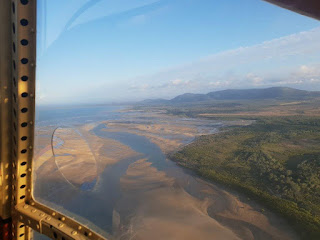We’ve had a few bike rides along the river near where we are
staying in isolation, and witnessed enthusiastic locals’ fishing from its banks
or in a tinnie. Always keen to get on the water, we set off to explore the mighty
O’Connell River and its mangrove tributaries, but unlike the locals, without
fishing gear.
 |
| Private boat 'ramp' on the O'Connell River |
The tide was rising as we launched the 5-metre aluminium dinghy down a rudimentary stony slope at the back of a cane field on our neighbour’s property. With a 3-knot tidal current against us, the 15-horsepower engine had no trouble taking us downstream towards the river mouth.
The O’Connell River is one of the largest rivers in the
Mackay Whitsunday region with a catchment area of 2,388 km²,
of which an area of 128 km² is composed of estaurine wetlands.
It’s small in comparison to other Queensland rivers but still impressive
nonetheless, especially from the air. A tidal range of near 5 metres is not
uncommon, changing the landscape of the river dramatically from one tide to the
next.
 |
| Near low tide at the O'Connell River mouth. Laguna Quays marina in the distance. |
Following the deeper channels and avoiding the sand bars, we
motored 2.5 nautical miles to the 400 metre-wide river mouth. To the south
there is a long beach that runs to the now derelict Laguna Quays Resort marina
(once home to a highly rated golf course and resort, and coincidentally where I
met my husband), and to the north is the infamous Proserpine River, Queensland’s
crocodile hotspot. It’s home to about 150 big crocs, and many breeding females
with lots of babies.
 |
| Ian at the helm |
 |
| Not quite enough water to pass through one of the many mangrove tributries |
Stretching between the Proserpine and O’Connell River mouths
is a 13 km long shoreline fronted by low beaches with a hotchpotch of weekender
tin shacks. As swimming is out of the question the mangrove lined creeks behind
the beach are a great place to explore in a motorised dinghy.
 |
| Grassy knoll at the bottom of the property |
 |
| View towards grassy knoll |
Fishing is the drawcard here. According to die-hard fisher
people, the O’Connell River and its catchment area ranks in the top five river
and creek fishing spots in Queensland. It has it all: barramundi, tarpon, sooty
grunter, and mangrove jack and the elusive jungle perch are all sought here.
Crab pots, or more precisely the rope attached, are a common sight in these
waterways too.
 |
Local pastime
|
Unlike the muddy Proserpine River, the O’Connell is sandy so
the only crocodiles it attracts are those that are passing through. Thankfully we didn't see one. However, there
is an infamous resident further upstream: a local farmer inherited a pet crocodile from his father many years ago. Charlie, but later renamed Charlene
due to the discovery of a cache of eggs, was a regular visitor of local human
watering holes in years past before he/she got too big. Now in keeping with the COVID-19
world, it is homebound for good. I do wonder who will outlive who, considering
crocodiles can live for 70 years or more.
 |
Charlene circa 1970s at the pub. Photo courtesy Whitsunday Times.
|
As lunch time approached, we were getting close to the top of
the tide and so ventured back upstream and attempted to circumnavigate a
sandy island opposite our ‘boat ramp’. A couple of Eastern Great Egrets flew
past as we softly ran aground on the sandy bottom. The tide was only 4.4 metres this day (tides are higher at night in this area at this time of year) - another 20 centimetres of water and
we could have made it round. Oh well, we'll just have to save that adventure for another day!
 |
| Newly named Paradise Inlet. |










No comments:
Post a Comment